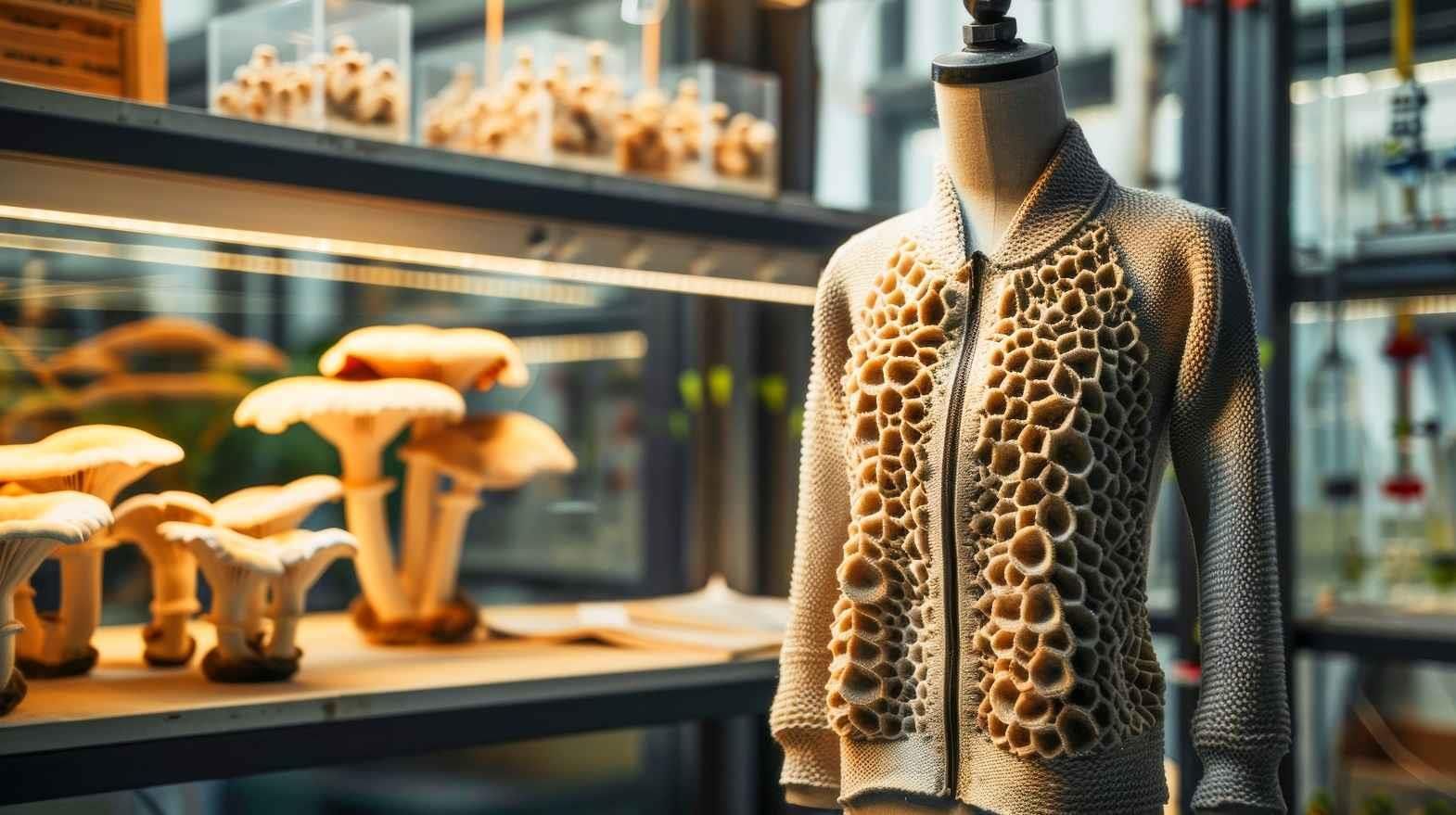The fashion and garment industry has a significant role in the degradation of the environment, mostly due to its resource-intensive production processes. In this context, looking into the potential applications of biotechnology for production of sustainable textiles using microorganisms like fungi, algae, and other organic materials acquires significance. The benefits of these biotechnological fabrics for the environment, future technological advancements, and practical applications are explored in this study. It gives a complete picture of how the manufacture of these textiles can have a smaller environmental impact than that of conventional textiles.
An increasing amount of attention is being paid to the textile industry’s effects on the environment, particularly carbon emissions, chemical use, and water consumption. Because traditional cloth production techniques are not sustainable, it is vital to investigate inventive substitutes. Because biotechnology can take advantage of germs, it presents a feasible option. It examines the development of textiles made from fungi, algae, and other organic elements to evaluate the potential for biotechnological advancements in fabric production to revolutionise the industry.
Traditional textile manufacturing has well-known environmental costs. For example, cultivating cotton requires a lot of water—up to 20,000 gallons are thought to be needed to produce one kilogram of cotton fabric (Chapagain et al., 2006). In addition, the process of dyeing textiles sends toxic chemicals into rivers, endangering both aquatic life and human health (Kant, 2012). Nayak et al. (2014) claim that synthetic fibres, such as polyester, significantly raise carbon emissions, exacerbating climate change.
Biotechnology in Textile Production
Using live organisms to create textiles is a more environmentally friendly option made possible by biotechnology. Previous research has shown that bacteria, fungi, and algae can all create textiles (Jones & Wang, 2018). Kirchherr et al. (2017) claim that these biotechnology methods offer reduced resource use and environmental effects, which is in line with the concepts of a circular economy.
Using a comprehensive review of the literature on the evolution of biotechnological textiles, this article examines case studies of companies and academic institutions that are setting the standard in this field and assesses the benefits these innovative textiles offer to the environment, the procedures used in their manufacture, and any disadvantages. A comprehensive analysis of the current and potential future states of biotechnological textiles is provided by the data gathered from industry reports, case studies, and peer-reviewed publications.
Algae-Based Fabrics
Algae, particularly microalgae, are becoming a more versatile supply for eco-friendly textiles. These microorganisms can be grown in wastewater, saltwater, and freshwater. Notable conclusions include:
Algal Biomass: Textiles can be made from algae by processing them into fibres. Since algae break down naturally, they offer a sustainable alternative to manufactured fibres (Volland et al., 2020).
Natural Colours: Algae offer safe, biodegradable natural colours that can be used in place of synthetic dyes without harming the environment (Kim et al., 2014).
Carbon Sequestration: Carbon emissions are decreased because photosynthetic algae absorb atmospheric carbon dioxide (Hannon et al., 2010).
Fungi-Related Fabrics
Mycelium, the vegetative part of fungi, holds enormous potential for the creation of sustainable fabrics. Crucial attributes include:
Biodegradability: Fabrics made of mycelium are naturally biodegradable, reducing the amount of trash that ends up in landfills (Jones et al., 2020).
Low Resource Requirements: Growing on agricultural waste and requiring minimal water, mycelium is a sustainable and effective option (Attias et al., 2021).
Versatility: A multitude of fashion applications are made possible by the ability to create mycelium to have a wide range of textures and properties (Elsacker et al., 2019).
Further Natural Resources
Research is also being done on the possibilities of bacterial cellulose and non-traditional plant fibres in the production of sustainable textiles:
Bacterial Cellulose: A naturally occurring polymer with a high tensile strength and water-holding capacity, cellulose is produced by some bacteria, according to Klemm et al. (2005). It is perfect for use in textile applications because of this.
Plant-Based Fibres: Processing fibres from hemp, bamboo, and banana plants is less harmful to the environment than processing cotton, according to Zhao et al. (2014).
Production of Biotechnological Textiles
Numerous companies and academic institutions are setting the standard for the production of biotechnological textiles. Leading examples include:
AlgiKnit: This firm produces biodegradable yarn from kelp, a form of seaweed. AlgiKnit’s yarn is designed to break down, offering a sustainable option to synthetic fibres (AlgiKnit, 2023).
MycoWorks: Using materials derived from mycelium, MycoWorks produces Reishi, a sustainable substitute for leather used in clothing and upholstery (MycoWorks, 2022).
Spinnova: Spinnova uses wood pulp and agricultural waste to manufacture sustainable fibres without the need of dangerous chemicals, producing the least amount of waste (Spinnova, 2021).
Biotechnological textiles are expected to see a bright future as a result of several themes that are expected to impact the industry:
Improved Production Techniques
Sustainable fabrics will become more economical, effective, and scalable through the simplification of biotechnological processes (Volland et al., 2020).
Enhanced Fabric Properties: Jones et al. (2020) claim that synthetic biology and genetic engineering will make it possible to create textiles with better performance features, such as increased resilience and self-healing capacity.
Circular Fashion Economy: By upholding the principles of the circular economy, biotechnological textiles promote sustainability throughout a garment’s lifetime (Kirchherr et al., 2017).
Consumer Awareness and Demand: Manufacturers will be compelled to employ biotechnology textiles as consumer awareness of the environment and demand for sustainable fashion both rise (Nayak et al., 2014).
Policy and Regulation: Government incentives for research and development along with stricter environmental rules will accelerate the adoption of biotechnological developments (Kant, 2012).
Challenges and Considerations
Although biotechnological fabrics have a lot of potential, there are a few problems that must be fixed first:
Scalability: A significant obstacle remains in developing scalable production methods to meet the global demand for textiles (Hannon et al., 2010).
Cost: Currently, employing biotechnology to produce textiles is more expensive than utilising traditional methods. More research and technological advancements are needed to reduce costs (Jones et al., 2020).
Consumer Acceptance: Customers must be informed about the benefits of biotechnological textiles and have any uncertainties dispelled for them to be broadly embraced (Nayak et al., 2014).
Ending Note
There is great promise for the use of biotechnology in the sustainable fashion industry. One way to develop unique textiles with a dramatically reduced environmental impact is to employ fungi, algae, and other organic ingredients. The pursuit of environmentally friendly clothing is becoming more feasible as science and technology advance. Though the shift to sustainable textiles is still in its infancy, there is hope for a more moral and ecologically conscious fashion business down the road and plenty of space for improvement.


 (1)20240730094415.jpg)







Comments